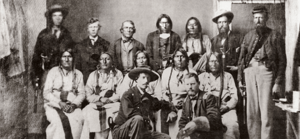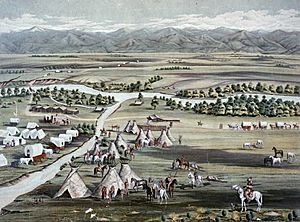Fort Weld facts for kids
Fort Weld, also known as Camp Weld, was a military camp built in Denver, Colorado. It was located on 30 acres of land east of the Platte River. Today, this area is part of the La Alma-Lincoln Park neighborhood.
The camp was named after Lewis Ledyard Weld. He was the very first Secretary of the Colorado Territory. Fort Weld was set up in September 1861 and was no longer used by 1865.
Soldiers at the camp practiced their drills in a large central square. Buildings surrounded this square. These buildings included places for soldiers to live, offices for officers, dining areas, a hospital, and a guard house. The main way to enter the camp was on its eastern side.
Fort Weld and the Civil War

Fort Weld was built in 1861 by Governor William Gilpin. Its main purpose was to protect the Colorado Territory. This was important during the Civil War. People in Denver were worried about attacks from Confederate soldiers. There were even rumors that troops from Texas were coming.
Soldiers from the 1st Colorado Infantry Regiment trained at Camp Weld. Their training helped stop Texan troops from moving further into the Western United States. John Chivington was one of the commanders at this camp.
Peace Talks with Native Americans
In September 1864, Arapaho and Cheyenne leaders met at Camp Weld. This meeting was called the Camp Weld Council. It was a peace talk between the Native American tribes and representatives from the Colorado Territory and the United States Army.
Important people at the council included Silas Soule, militia commander John Chivington, and Governor John Evans. Major Edward W. Wynkoop was also there. The goal was to create peace between the tribes and the European settlers. The Arapaho and Cheyenne leaders believed they had agreed to the peace terms.
However, efforts by Governor Evans and later actions led to a tragic event. This event, known as the Sand Creek massacre (November 29, 1864), was led by Chivington. A study by scholars called it "a deep moral failure." This meant the peace efforts did not last, and a terrible conflict happened instead.
What Happened to the Camp?
Fort Weld was eventually destroyed by two fires. After the fires, one soldier claimed a piece of land. This land was part of Officer's Row, which was the last part of the camp still standing.
He built a home there and raised his family. He also created fish ponds and planted fruit trees on the land. For many years, he ran a picnic ground and a market there.
In 1934, a special marker was put up at 8th and Vallejo streets. It is made of bronze and granite. The marker tells us about the history of Camp Weld. It says the camp was established in September 1861 for Colorado Civil War volunteers. It also mentions that troops from the camp won a victory in New Mexico in 1862. This victory helped save the Southwest for the Union. The marker also notes that the camp was a headquarters against Native Americans from 1864-1865. The camp was abandoned in 1865.


